Stories
Stories
Liberty Bonds and the First Lancaster to New Zealand
The New Zealand government financed the country’s contribution to World War II from internal resources, raising substantial amounts through taxation, internal loans, and encouraging people to put money into National Savings accounts. Contributions could be made either individually or through workplace groups. Employees could authorise their employers to transfer regular amounts from their wages into National Savings accounts. Savings bonds and accounts bore interest at 3 percent, and the money invested in National Savings was paid into the government’s War Expenses Account.
Savings and bonds were promoted to the public in several ways. Posters played a significant part in the fund-raising campaigns, making intense appeals to New Zealanders’ sense of patriotism and sacrifice. But perhaps the most dramatic was the visit in 1943 of the first Lancaster bomber to New Zealand.
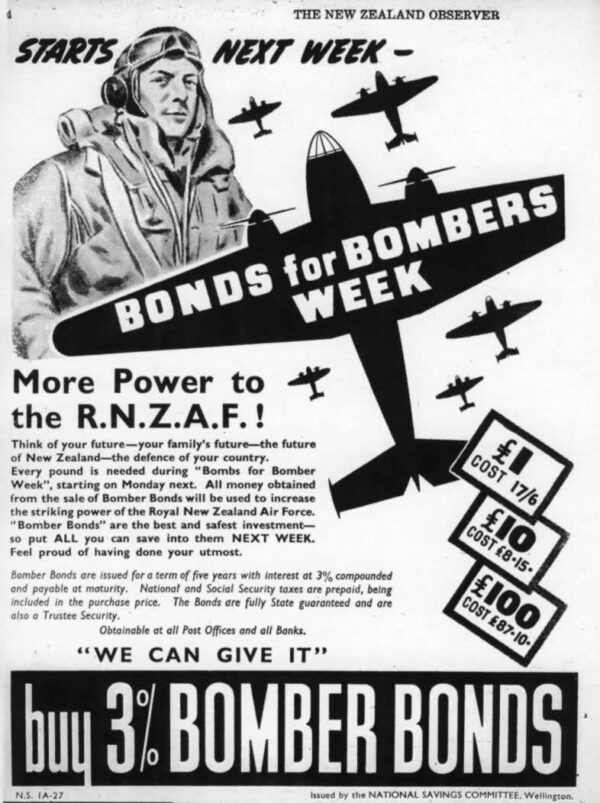
Bonds For Bombers Advertisement from the New Zealand Observer, 25th of March 1942.
(Credit: Wings Over Cambridge website)
One Lancaster had been earmarked during production for a remarkable flight to Australia. It was originally planned to be brought to Australia so that it could serve as a template for local production of the type, but this never took place. Instead it was used for exhibition flights to encourage purchase of war bonds both in Australia and New Zealand.
On 22 May 1943, the brand-new Lancaster “Q” for Queenie, ED 930, took off from Prestwick in Scotland headed for Amberley in Australia. It flew via Montreal, Toronto, San Francisco, Honolulu (Hawaii), Palmyra Atoll (Northern Line Islands), Canton Island (Kiribati), Nadi (Fiji), finally arriving at Amberley airfield, west of Brisbane, on 4 June 1943. The flying time for the long journey was 74 hours.
The crew for the flight were all RAAF, led by Flight Lieutenant Peter Isaacson, DFC, AFC, DFM (Pilot). He was chosen to lead the landmark flight, having completed forty-five sorties, firstly with No. 46 Sq., then No. 156 (PFF) Sq. With Isaacson were Flight Lieutenant Robert Nielsen, DFM (Navigator), Flight Lieutenant Alan Ritchie, DFM (2nd Navigator & Bomb Aimer), Pilot Officer M.D. (Don) Delaney (Flight Engineer), Pilot Officer E.M. (Bill) Copley, DFM (Wireless / Air Gunner), Flight Sergeant J. Grose (Air Gunner), Flight Sergeant Archie Page (Air Gunner) and Corporal Claude Spencer (Airframe Fitter).
Arriving at Amberley, Queenie had two extra VIP passengers on board. They were Lord Burghley, British Controller of Repairs and Overseas Supplies and Group Captain C.B. Wincott (RAF) from the British Air Mission in Washington, USA”
The final stage of the epic journey was to New Zealand on 11 June, where it spent a week, including a tour of almost the entire country, before returning to Australia.
Leaflets in support of the Third Liberty Loan were dropped from the Lancaster over towns and cities. They could be redeemed for a Bond worth one pound.
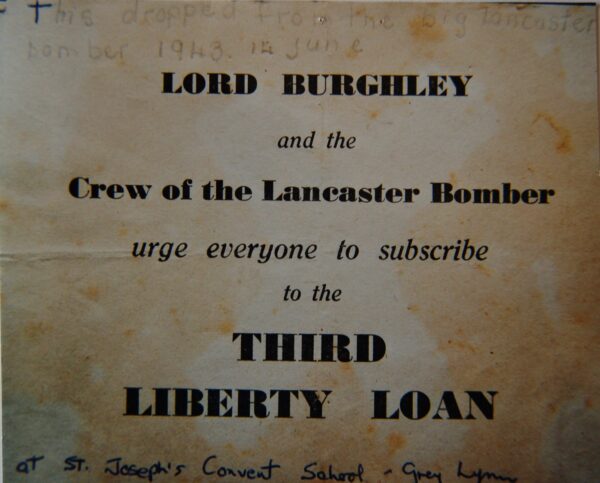
Leaflet dropped by Queenie over Auckland, 14 June 1943.
(Credit: Wings Over Cambridge website)
A Press Association report covered the Lancaster’s arrival in Christchurch:
WELCOME IN CHRISTCHURCH – GREAT CROWD AT WIGRAM
(P.A.) CHRISTCHURCH, Sunday
Thousands of Christchurch people witnessed the arrival of the giant four-engined Lancaster bomber at Wigram yesterday afternoon in the course of its New Zealand tour. The arrival of the Lancaster over the city was reminiscent of the days of the first Tasman flights. Long before the bomber was due crowded trains and streams of cars were on the road leading to Wigram.
The Lancaster, escorted by two Kittyhawks, left Blenheim at 2.35 p.m. and flew over Kaikoura and towns in North Canterbury. It circled the Christchurch aerodrome and landed at 4.55.
The first to welcome the captain of the aircraft, Flight-Lieutenant P. Isaacson, and the crew of seven was Lady Newall. She was followed by the Mayor of Christchurch, Mr. E. H. Andrews. Others included representatives of the Navy and Army, the Leader of the Opposition, Mr. S. G. Holland, and Archbishop West-Watson.
The official party inspected the Lancaster inside a rope enclosure. A huge crowd allowed outside the enclosure rushed the airfield the moment the bomber’s engines stopped.
The aircraft left Wigram shortly after nine o’clock this morning and flew south as far as Invercargill. It visited Lumsden and Queenstown, crossed the island to Jackson’s Bay, flew up the west coast over Greymouth, Westport and other towns to Nelson.
Then it went over Wellington and Ohakea. The Lancaster has flown approximately 2000 miles in slightly more than 12 hours as the first instalment of the New Zealand tour.
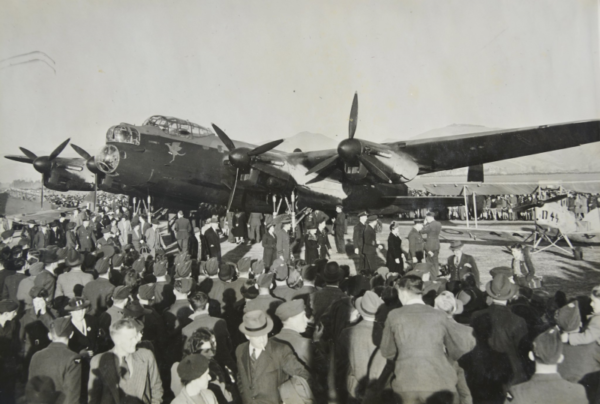
Crowds gathered in great numbers to see Queenie at Wigram.
(Credit: Air Force Museum of New Zealand)
The New Zealand Herald carried the following story on 14 June 1943:
LARGE BOMBER FLIGHT TO AUCKLAND
OVER THE CITY AT MID-DAY
The large four-engined British Avro Lancaster bomber which was recently flown from England by Flight-Lieutenant P. Isaacson, D.F.C., D.F.M., and an Australian crew, will fly over Auckland at about mid-day to-day before landing at Whenuapai. Since its arrival in New Zealand from Melbourne on Friday the aircraft has made a tour of southern centres.
Officers and cadets of the Air Training Corps and relatives of personnel serving with the Royal Air Force will be permitted to visit the station and see the machine on the ground tomorrow. It has been arranged that the airfield will be open to those visitors tomorrow between 10 a.m. and 4 p.m.
The Mayor, Mr. J. A. C. Allum, also will visit the station to inspect the bomber.
To allow the public to see the machine in flight, an itinerary for the trip north has been planned to take it over five main centres this morning, if weather and other circumstances permit. The schedule arranged is as follows: Rotorua, 10.50 a.m.; Cambridge, 11.15 a.m.; Hamilton, 11.20 a.m.; Thames, 11.40 a.m.; and Auckland, mid-day.
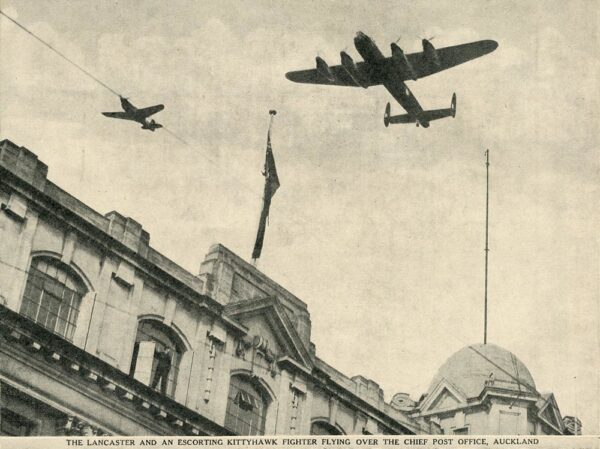
Queenie, with a supporting RNZAF Kittyhawk over the Auckland Chief Post Office.
(Credit: Wings Over Cambridge website)
Quennie made a direct return flight, Whenuapai – Melbourne on 19 June 1943. Departure was a day later than scheduled due to the slight mishap the preceding day when Queenie was slightly damaged when it skidded while taking off. Following repairs and a test flight, she proved airworthy for the return journey.
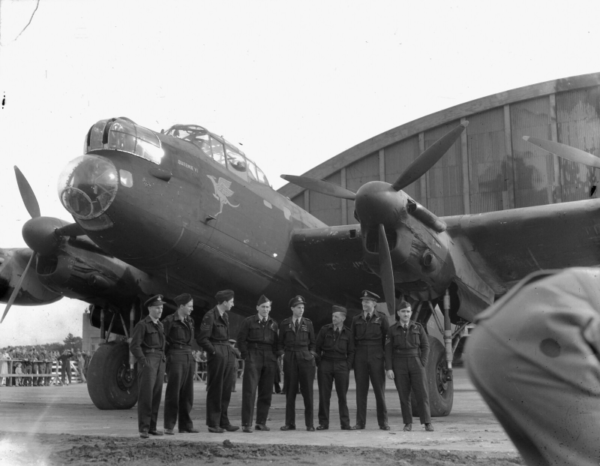
The crew of RAAF Lancaster ED930 (A66-1) “Queenie VI” in front of their aircraft at RNZAF Station Whenuapai. – June 1943.
(Credit: Air Force Museum of New Zealand)
In late 1943 Queenie was taken on charge by the RAAF as A66-1. “Queenie” arrived at Richmond on 20 October in preparation for carrying out a series of exhibition flights over Sydney.
During one of these sorties the crew, captained by Flight Lieutenant Peter Isaacson, decided to ‘buzz’ the building housing the headquarters of RAAF Eastern Area at Edgecliff, on Double Bay, before taking A66‑1 beneath the harbour bridge-in defiance of a 1931 regulation banning such flights. The Lancaster was not the first aircraft (nor even the last) to break this prohibition, but it was the largest In October 1943 Queenie had the honour (record) for the largest aircraft to fly under the Sydney Harbour Bridge.
Image: Harbour Bridge
Avro Lancaster bomber ‘Q for Queenie,’ piloted by Flight Lieutenant Peter Isaacson flies under the Sydney Harbour Bridge on 22 October 1943.
Queenie crashed on 26 October 1943 at Evans Head. The aircraft suffered a wind change when landing and ran off the end and ended up in a ditch severely damaged. Repairs needed 10 crates of parts to be sent from Canada and took until 4 April 1944. Initially thought to be a write-off, it turned out to be the biggest field service repair in RAAF history.
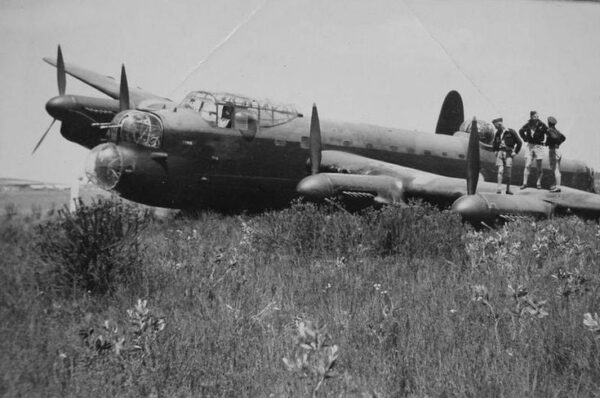
RAAF Lancaster (A66-1 Q-Queenie) after running off the runway at Evans Head, NSW in October 1943.
It was reported in 1944 that “Q for Queenie,” was to be decommissioned having raised 12,750.000 Pounds for Australian war loans.
After the war, “Q” for Queenie was stored at Tocumwal (NSW) and in June 1949 it was converted to components at East Sale in Victoria. The stripped aircraft was towed to the Armament School at Dunston, where it was used for target practice. Sadly, it was later melted down to ingots at Wagga.
References:
Sally Elizabeth Douglas: RAF Lancaster Four Engined Bomber ‘Queenie VI’ arrived in Amberley on 4 June 1943